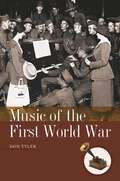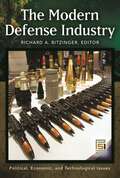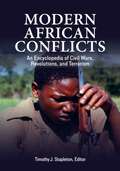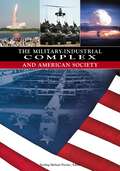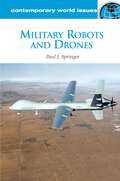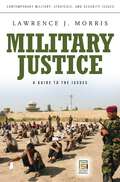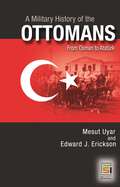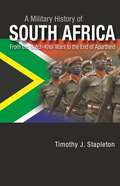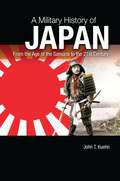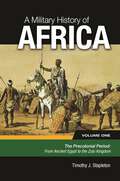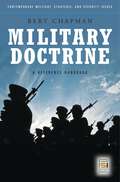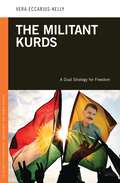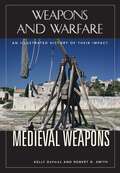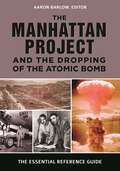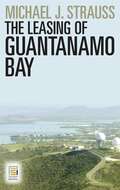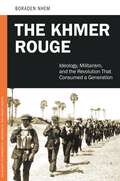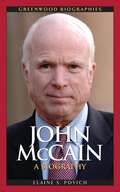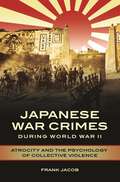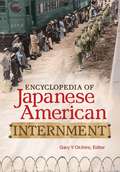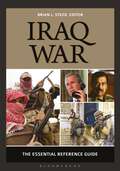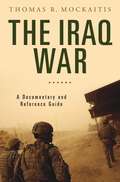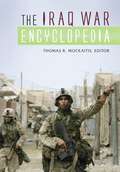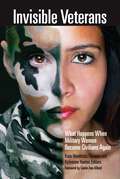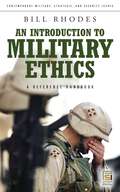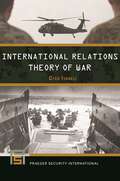- Table View
- List View
Music of the First World War (American History through Music)
by Don TylerThis book discusses WWI-era music in a historical context, explaining music's importance at home and abroad during WWI as well as examining what music was being sung, played, and danced to during the years prior to America's involvement in the Great War.Why was music so important to soldiers abroad during World War I? What role did music—ranging from classical to theater music, rags, and early jazz—play on the American homefront? Music of the First World War explores the tremendous importance of music during the years of the Great War—when communication technologies were extremely limited and music often took the place of connecting directly with loved ones or reminiscing via recorded images.The book's chapters cover music's contribution to the war effort; the variety of war-related songs, popular hits, and top recording artists of the war years; the music of Broadway shows and other theater productions; and important composers and lyricists. The author also explores the development of the fledgling recording industry at this time.
The Modern Defense Industry: Political, Economic, and Technological Issues (Praeger Security International)
by Richard A. BitzingerWhether it's guns and ammunition or multidimensional anti-terrorism systems, the defense industry is dynamic, complex, and ubiquitous. It is also mysterious, powerful, and controversial, involving thousands of players worldwide—from suppliers and producers to government and military procurers to shadowy figures that trade in the black market. This comprehensive, two-volume reference will explore, on a global scale, the various issues, concepts, problems, and controversies surrounding the rise of the modern defense industry. Unparalleled in its scope and insight, The Modern Defense Industry will prove invaluable to the industry's critics and champions alike.The phenomenon of a more-or-less permanent defense industry—especially one so wide in scale, breadth (air, sea, land, and space), technology, and geography—is still relatively new. Until now, its implications for politics, economics, and technology have not been adequately discussed in an authoritative, accessible format for scholars and researchers, business people, journalists, policymakers, and interested laymen.The Modern Defense Industry addresses the period from 1945 to the present, covering the United States, Europe, Russia, China, Israel, and other important arms-producing and arms-procuring countries. Including essays by experts from around the world, a glossary, data on firms and governments, laws and policies, primary documents, case studies, and a host of other elements, this set will be a unique resource for anyone interested in the arms industry. It will also offer penetrating insights into topics like international relations and diplomacy, arms proliferation, and contemporary politics. Volume I comprises chapters by experts in the field on topics like the relationship between the industry, military, and government; how new modes of warfare are changing the industry; the implications of globalization on the industry; the black and gray areas of the arms trade; and much more. Volume II features an extensive A-Z glossary of terms, lists of defense firms and government agencies, annotated primary documents, lists of leading defense contractors and key weapons systems, an analysis of key legislation, and professional organizations.The Modern Defense Industry sets the standard for state of the art overviews of an industry that has, for better or worse, come to infuse nearly every aspect of world affairs in the early twenty-first century.
Modern African Conflicts: An Encyclopedia of Civil Wars, Revolutions, and Terrorism
by Timothy J. StapletonAn essential resource for students or general readers interested in post-colonial Africa, this encyclopedia provides coverage of different regions, countries, wars, battles, factions, leaders, and foreign powers.Armed conflict represents a substantial part of African history since around 1960, yet this history is either insufficiently taught or overshadowed by negative stereotypes about African "tribal warfare."In an effort to introduce this vital topic to students and general readers alike, this one-volume encyclopedia provides concise historical information on conflicts that occurred in postcolonial Africa. The entries cover all the regions of Africa (North, West, Central, East, and Southern); the Cold War and post–Cold War periods; a range of important leaders; various types of conflicts from civil wars and insurgencies to conventional military engagements; involvement of foreign powers; and such themes as airpower, women and war, and genocide.
The Military-Industrial Complex and American Society
by Sterling Michael PavelecThe first complete reference on the military-industrial complex, from its Cold War era expansion to the present.The Military-Industrial Complex and American Society addresses the broad subject of the political economy of defense research and its wide-reaching effects on many aspects of American life. Ranging from the massive arms buildup of the Cold War to the influx of private contractors and corporations such as Halliburton, it reveals the interconnectedness of the military, industry, and government within the history of this public/private enterprise.The Military-Industrial Complex and American Society offers over 100 alphabetically organized entries on a wide of range of significant research bodies and government agencies, as well as important people, events, and technologies. In addition, a series of essays looks at such essential topics as propaganda, think tanks, defense budgeting, the defense industry and the economy, and the breakdown of the military-industrial complex in Vietnam. With this work, students, policymakers, and other interested readers will understand the ramifications of the relationships between industry, scientific and technological communities, the government, and society.
Military Robots and Drones: A Reference Handbook (Contemporary World Issues)
by Paul J. SpringerThis book provides an insightful introduction to the most important field of military innovation for the 21st century—robotic and drone weaponry.For centuries, warring nations have sought to lower the risk to highly vulnerable humans on the battlefield, typically by providing protective armor, making soldiers' positions more difficult to detect, or by striking from locations safe from retaliation. Autonomous weaponry has now reached the point where robotic systems can perform some key tasks that previously required direct human involvement.Military Robots and Drones: A Reference Handbook introduces the lay person to a highly specialized topic, providing the foundation necessary for further study in this field. Appropriate for high school and college-level students, as well as general readers with an interest in the topic, the author explains the many military applications of robotics as well as current limitations and disadvantages. The book also provides a general history of robotic warfare; examines key individuals, agencies, documents, and models; discusses controversies within the field of robotic and drone warfare, such as ethical considerations; and explains how increased reliance on robotics has affected the structure and strategy of the military.
Military Justice: A Guide to the Issues (Contemporary Military, Strategic, and Security Issues)
by Lawrence J. MorrisPublic, press, and academic interest in the military justice system has increased over the past generation. This is a result of several high-profile trials (the Sergeant Major of the Army and Kelly Flinn, among many others), a popular TV show (even if it was Navy JAGs), and broader public attention to and interest in the military, stemming from the post-Cold War prominence of the military (Gulf War I, Balkans, and post-9/11 operations). In addition, some of the more prominent cases from the war in Iraq, including Abu Ghraib and detainee cases, as well as the GTMO military commissions, have kept military justice in the news. There are many misconceptions about the rudiments of the military justice system. Many perceive severity where there is none (though there are features that differ from the civilian system, sometimes unfavorably for the accused), and few are aware of its unique protections and features. Senators Lott and McConnell were not unique in the inaccurate perceptions they publicly stated about military justice during hearings on military tribunals. This volume would accomplish two main purposes: (1) provide comprehensive, accurate, and current information about the military justice system and related disciplinary features, written in laymen's language; and (2) explain the system through some illustrative or engaging anecdotes (e.g., the trials of Billy Mitchell, William Calley, and the World War II Nazi saboteurs, whose capture and trial provide the basis for today's Guantanamo-based trials of suspected terrorists).
A Military History of the Ottomans: From Osman to Atatürk
by Mesut Uyar Ph.D. Edward J. EricksonThe Ottoman Army had a significant effect on the history of the modern world and particularly on that of the Middle East and Europe. This study, written by a Turkish and an American scholar, is a revision and corrective to western accounts because it is based on Turkish interpretations, rather than European interpretations, of events. As the world's dominant military machine from 1300 to the mid-1700's, the Ottoman Army led the way in military institutions, organizational structures, technology, and tactics. In decline thereafter, it nevertheless remained a considerable force to be counted in the balance of power through 1918. From its nomadic origins, it underwent revolutions in military affairs as well as several transformations which enabled it to compete on favorable terms with the best of armies of the day. This study tracks the growth of the Ottoman Army as a professional institution from the perspective of the Ottomans themselves, by using previously untapped Ottoman source materials. Additionally, the impact of important commanders and the role of politics, as these affected the army, are examined. The study concludes with the Ottoman legacy and its effect on the Republic and modern Turkish Army.This is a study survey that combines an introductory view of this subject with fresh and original reference-level information. Divided into distinct periods, Uyar and Erickson open with a brief overview of the establishment of the Ottoman Empire and the military systems that shaped the early military patterns. The Ottoman army emerged forcefully in 1453 during the siege of Constantinople and became a dominant social and political force for nearly two hundred years following Mehmed's capture of the city. When the army began to show signs of decay during the mid-seventeenth century, successive Sultans actively sought to transform the institution that protected their power. The reforms and transformations that began frist in 1606successfully preserved the army until the outbreak of the Ottoman-Russian War in 1876. Though the war was brief, its impact was enormous as nationalistic and republican strains placed increasing pressure on the Sultan and his army until, finally, in 1918, those strains proved too great to overcome. By 1923, Mustafa Kemal Atatürk emerged as the leader of a unified national state ruled by a new National Parliament. As Uyar and Erickson demonstrate, the old army of the Sultan had become the army of the Republic, symbolizing the transformation of a dying empire to the new Turkish state make clear that throughout much of its existence, the Ottoman Army was an effective fighting force with professional military institutions and organizational structures.
A Military History of South Africa: From the Dutch-Khoi Wars to the End of Apartheid
by Timothy J. StapletonThis work offers the first one-volume comprehensive military history of modern South Africa.A Military History of South Africa: From the Dutch-Khoi Wars to the End of Apartheid represents the first comprehensive military history of South Africa from the beginning of European colonization in the Cape during the 1650s to the current postapartheid republic. With particular emphasis on the last 200 years, this balanced analysis stresses the historical importance of warfare and military structures in the shaping of modern South African society. Important themes include military adaptation during the process of colonial conquest and African resistance, the growth of South Africa as a regional military power from the early 20th century, and South African involvement in conflicts of the decolonization era. Organized chronologically, each chapter reviews the major conflicts, policies, and military issues of a specific period in South African history. Coverage includes the wars of colonial conquest (1830-69), the diamond wars (1869-81), the gold wars (1886-1910), World Wars I and II (1910-45), and the apartheid wars (1948-94).
A Military History of Japan: From the Age of the Samurai to the 21st Century
by John T. KuehnThis comprehensive volume traces the evolution of Japanese military history—from 300 AD to present day foreign relations—and reveals how the country's cultural views of power, violence, and politics helped shape Japan's long and turbulent history of war.The legacy of Japanese warfare is steeped in honor, duty, and valor. Yet, some of the more violent episodes in this country's military history have tainted foreign attitudes toward Japan, oftentimes threatening the economic stability of the Pacific region. This book documents Japan's long and stormy history of war and military action, provides a thorough analysis of the social and political changes that have contributed to the evolution of Japan's foreign policy and security decisions, and reveals the truth behind the common myths and misconceptions of this nation's iconic war symbols and events, including samurais, warlords, and kamikaze attacks.Written by an author with military experience and insight into modern-day Japanese culture gained from living in Japan, A Military History of Japan: From the Age of the Samurai to the 21st Century examines how Japan's history of having warrior-based leaderships, imperialist governments, and dictators has shaped the country's concepts of war. It provides a complete military history of Japan—from the beginning of the Imperial institution to the post-Cold War era—in a single volume. This thoughtful resource also contains photos, maps, and a glossary of key Japanese terms to support learning.
A Military History of Africa [3 volumes]: [3 volumes]
by Timothy J. StapletonA detailed and thorough chronological overview of the history of warfare and military structures in Africa, covering ancient times to the present day.A Military History of Africa achieves a daunting task: it synthesizes decades of specialized academic research and literature—including the most recent material—to offer an accessible survey of Africa's military history, from the earliest times to the present day. The first volume examines the precolonial period beginning with warfare in ancient North Africa including ancient Egypt and Carthage and continues through the cavalry-based Muslim empires of the trans-Sahara trade and the wars of the slave trade in West and East Africa. The second volume focuses on the wars of European colonial conquest and African resistance during the late 19th century, African participation in both world wars, and the early violent struggles for independence from the 1950s and early 1960s. The third volume explores warfare in postcolonial Africa, including coverage of the impact of the global Cold War, conflicts in Southern Africa from the 1960s to 1980s, the development of postcolonial African armed forces, and civil wars sparked by the discovery of precious resources, such as diamonds in Sierra Leone. Readers of this three-volume work will understand how warfare and military structures have been consistently central to the development of African societies.
Military Doctrine: A Reference Handbook (Contemporary Military, Strategic, and Security Issues)
by Bert ChapmanThis comprehensive volume provides a thorough overview of 20th- and 21st-century military doctrines worldwide.Military Doctrine: A Reference Handbook takes a thorough look at 20th- and 21st-century military doctrines around the world. It excerpts relevant English-language scholarly and governmental literature to paint a picture of how military doctrine has developed in recent history, what military doctrines are currently operating on the world stage, and where military doctrine is heading in the near future. The book casts a wide net, scanning the relevant government documents, international agreements, monographs, journals, conference papers, and Internet resources to present a thorough overview of the importance of military doctrine in today's highly unstable world. Because military institutions are important formulators of national military doctrine and not merely implementers, this book examines the roles played by military organizations around the world. With the proliferation of independent military scholars and the widespread influence of their work in the Internet age, the book also scans the "gray" literature and describes its effects on military doctrine.
The Militant Kurds: A Dual Strategy for Freedom (PSI Guides to Terrorists, Insurgents, and Armed Groups)
by Vera Eccarius-KellyThis extensive examination of the Kurdish conflict in Turkey, Iraq, Germany, and the EU focuses on the history and development of the Kurdish Workers Party (PKK) and its impact on transnational security, human rights, and democratization.The Militant Kurds: A Dual Strategy for Freedom explores the complexity of the 30-year guerrilla war of the Kurdish Workers Party (PKK) against the Turkish Republic, identifying longstanding obstacles to peace and probing the new dynamics that may lead to an end to the conflict. In doing so, the book provides fascinating insights into Turkey's national ethos, its dominant military culture, and civil society's struggle for increased democratization.The Militant Kurds offers an extensive analysis of the precarious position of the Kurdish minority, beginning with the establishment of the modern Turkish republic in 1923. Divided into five sections examining current political realities in Turkey, the book investigates the role of Islam and ethnicity, analyzes the rise of the PKK, discusses Turkish military culture, and explains the international dimensions of the Kurdish conflict. Comparative historical, political, and socioeconomic examples contextualize the long struggle for Kurdish self-determination. Each chapter offers an analysis of the underlying dynamics of the conflict and provides up-to-date explanations.
Medieval Weapons: An Illustrated History of Their Impact (Weapons and Warfare)
by Robert D. Smith Kelly DeVriesThis fascinating reference covers the weapons and armor used by warriors from the 4th to the 15th century and discusses how and why they changed over time.In the Middle Ages, the lack of standardized weapons meant that one warrior's arms were often quite different from another's, even when they were fighting on the same side. And with few major technological advances in that period, the evolution of those weapons over the centuries was incremental. But evolve they ultimately did, bringing arms, armor, and siege weapons to the threshold of the modern era. From the fall of the Roman Empire to the beginnings of the Renaissance, Medieval Weapons: An Illustrated History of Their Impact covers the inexorable transformation from warrior in the mail shirt to fully armored knight, from the days of spears and swords to the large-scale adoption of the handgun.Medieval Weapons covers this fascinating expanse of centuries in chapters devoted to the early medieval, Carolingian, Crusade, and late medieval periods. Within each period, the book details how weapons and armor were developed, what weapons were used for different types of battles, and how weapons and armor both influenced, and were influenced by, changing tactics in battles and sieges.
The Manhattan Project and the Dropping of the Atomic Bomb: The Essential Reference Guide
by Aaron BarlowThis invaluable resource offers students a comprehensive overview of the Manhattan Project and the decision to drop the atomic bomb, with more than 80 in-depth articles on a variety of topics and dozens of key primary source documents.This book provides everything readers need to know about the Manhattan Project, the U.S. program that led to the development of the atomic bomb during World War II. It begins with a detailed introduction to the project and includes an alphabetical collection of relevant entries on such topics as the Enola Gay, the first aircraft to drop an atomic bomb; Enrico Fermi, creator of the first nuclear reactor; Hiroshima, the target of the first atomic bomb; and Robert Oppenheimer, director of the Manhattan Project.Dozens of primary sources include eyewitness accounts, government memos, letters, press releases, and other important documents relevant to the establishment and success of the Manhattan Project. A set of four essays written by prominent scholars address whether the United States was justified in dropping the atomic bomb on Japan. The book also includes a comprehensive chronology that reveals key moments related to the creation of the world's first nuclear weapon as well as a bibliography of resources that points readers toward additional information on the Manhattan Project, nuclear weapons, and World War II.
The Leasing of Guantanamo Bay (Praeger Security International)
by Michael J. StraussPost-2002 events at the U.S. naval facility at Guantanamo Bay have generated a spate of books on its use as a detention center in the U.S. fight against terrorism. Yet the crucial enabling factor-the lease that gave the U.S. control over the territory in Cuba-has till now escaped any but cursory consideration. The Leasing of Guantanamo Bay explains just how Guantanamo Bay came to be a leased territory where the U.S. has no sovereignty and Cuba has no jurisdiction. This is the first definitive account of the details and workings of the unusual and problematic state-to-state leasing arrangement that is the essential but murky foundation for all the ongoing controversies about Guantanamo Bay's role in U.S. anti-terrorism efforts, charges of U.S. human rights violations, and U.S.-Cuban relations.The Leasing of Guantanamo Bay provides an overview of territorial leasing between states and shows how it challenges, compromises, and complicates established notions of sovereignty and jurisdiction. Strauss unfolds the history of the Guantanamo Bay, recounting how the U.S. has deviated widely from the original terms of the lease yet never been legally challenged by Cuba, owing to the strong state-weak state dynamics. The lease is a hodge-podge of three U.S.-Cuba agreements full of discrepancies and uncorrected errors. Cuba's failure to cash the annual rent checks of the U.S. has legal implications not only for the future of Guantanamo Bay but of the Westphalian system of states. Compiled for the first time in one place are the verbatim texts of all the key documents relevant to the Guantanamo Bay lease-including treaties and other agreements, a previously unpublished U.N. legal assessment, and once-classified government correspondence.
The Khmer Rouge: Ideology, Militarism, and the Revolution That Consumed a Generation (PSI Guides to Terrorists, Insurgents, and Armed Groups)
by Nhem BoradenThis book provides a comprehensive yet concise narrative of the history of the Khmer Rouge, from its inception during the 1950s through its eventual reintegration into Cambodian society in 1998.The Khmer Rouge: Ideology, Militarism, and the Revolution That Consumed a Generation examines the entire organizational life of the Khmer Rouge, looking at it from both a societal and organizational perspective. The chapters cover each pivotal period in the history of the Khmer Rouge, explaining how extreme militarism, organizational dynamics, leadership policies, and international context all conspired to establish, maintain, and destroy the Khmer Rouge as an organization. The work goes beyond inspecting the actions of a few key leadership individuals to describe the interaction among different groups of elites as well as the ideologies and culture that formed the structural foundation of the organization.
John McCain: A Biography (Greenwood Biographies)
by Elaine S. PovichA rebel and risk-taker from childhood, John McCain—son and grandson of admirals—nevertheless chose to follow the traditional path marked out for him in the military. Nearly six years in a North Vietnamese prison tested his resolve and proved his extraordinary resilience and will to survive. Coming to Congress, McCain found that making his way in politics demanded a different set of survival skills, and he grew accustomed to the corridors of power while striving to keep his independence. This lively biography traces McCain's unlikely ascent to the verge of attaining the nation's highest office while never ceasing to challenge himself and others to serve a cause greater than self-interest.
Japanese War Crimes during World War II: Atrocity and the Psychology of Collective Violence
by Frank JacobA challenging examination of Japanese war crimes during World War II offers a fresh perspective on the Pacific War—and a better understanding of reasons for the wartime use of extreme mass violence.The 1937 Rape of Nanjing has become a symbol of Japanese violence during the Second World War, but it was not the only event during which the Japanese used extreme force. This thought-provoking book analyzes Japan's actions during the war, without blaming Japan, helping readers understand what led to those eruptions. In fact, the author specifically disputes the idea that the forms of extreme violence used in the Pacific War were particularly Japanese.The volume starts by examining the Rape of Nanjing, then goes on to address Japan's acts of individual and collective violence throughout the conflict. Unlike other works on the subject, it combines historical, sociological, and psychological perspectives on violence with a specific study of the Japanese army, seeking to define the reasons for the use of extreme violence in each particular case. Both a historical survey and an explanation of Japanese warfare, the book scrutinizes incidents of violence perpetrated by the Japanese vis-à-vis theories that explore the use of violence as part of human nature. In doing so, it provides far-reaching insights into the use of collective violence and torture in war overall, as well as motivations for committing atrocities. Finally, the author discusses current political implications stemming from Japan's continued refusal to acknowledge its war-time actions as war crimes.
Encyclopedia of Japanese American Internment
by Gary Y. OkihiroThis book addresses the forced removal and confinement of Japanese Americans during World War II—a topic significant to all Americans, regardless of race or color.The internment of Japanese Americans was a violation of the Constitution and its guarantee of equal protection under the law—yet it was authorized by a presidential order, given substance by an act of Congress, and affirmed by the U.S. Supreme Court. Japanese internment is a topic that we as Americans cannot afford to forget or be ignorant of. This work spotlights an important subject that is often only described in a cursory fashion in general textbooks. It provides a comprehensive, accessible treatment of the events of Japanese American internment that includes topical, event, and biographical entries; a chronology and comprehensive bibliography; and primary documents that help bring the event to life for readers and promote inquiry and critical thinking.
Iraq War: The Essential Reference Guide
by Brian L. Steed, EditorThis invaluable resource offers a comprehensive overview of the Iraq War, with more than 100 in-depth articles by leading scholars on an array of topics and themes and more than a dozen key primary source documents.This book provides everything the reader needs to know about the Iraq War, from the Bush administration's decision to invade Iraq, through the U.S. troop surge in 2007, to the rise of the Islamic State. It offers insight into the war through the events, organizations, and people who have had a major impact on the conflict. It also explains the inadvertent consequences of the conflict including worsening regional sectarian divisions, the Arab Spring, the increase in Iranian influence in the Middle East, and the expansion of international terrorism.The book begins with a sweeping overview of the Iraq War that provides context for each of the reference entries that follow. The introductory material also includes detailed essays on the causes and consequences of the war. The bulk of the book consists of more than 120 reference entries on such topics as Saddam Hussein, the battles of Fallujah, and private military contractors such as Blackwater and Halliburton. In addition, the book includes more than a dozen curated and contextualized primary source documents along with a comprehensive chronology and extensive bibliography.
The Iraq War: A Documentary and Reference Guide (Documentary and Reference Guides)
by Thomas R. MockaitisIdeal for general readers as well as professionals conducting extensive research, this informative book offers a collection of documents on the origins and conduct of the Iraq War.The Iraq War: A Documentary and Reference Guide gives readers the opportunity to investigate this costly and controversial conflict as professional researchers do—by looking closely at key samples of historical evidence. As readers will see, that evidence proves to be extraordinarily revealing about the drive to war, the course of the initial invasion, the counterinsurgency, the "surge," and the continuing difficulties in unifying and stabilizing the country.From relevant exchanges in the 2000 Bush/Gore debates to interviews with Saddam Hussein to the latest reorganization of the Coalition Provisional Authority, The Iraq War gives readers an insider's view of the conflict's key decisions and events. Each chapter brings together primary and secondary sources on an important phase of the war, with the author providing context, analysis, and insight from a historian's perspective. The book also provides a solid framework for working with the documentary record—a particularly difficult task in this case, as so many vital sources will remain classified and inaccessible for years to come.
The Iraq War Encyclopedia
by Thomas R. MockaitisThis reference work is an ideal resource for anyone interested in better understanding the controversial Iraq War. It treats the war in its entirety, covering politics, religion, and history, as well as military issues.The Iraq War started in 2003 in a quest to rid the nation of weapons of mass destruction (WMDs) that were never found. It lasted over 8 years, during which more than 30,000 U.S. service members were wounded and almost 4,500 American lives lost. Comprised of some 275 entries, this comprehensive encyclopedia examines the war from multiple points of view. Each article is written by an expert with specialized knowledge of the topic.The reference covers every aspect of the Iraq War, from the U.S. invasion (Operation IRAQI FREEDOM) through the rise of Al Qaeda in Iraq, the surge, and the U.S. withdrawal. Other significant aspects of the conflict are addressed as well, including Abu Ghraib, WMDs, the controversial use of private military contractors, and Britain's role in the war. The book also features an overview essay, a "causes and consequences" essay, maps, photos, a chronology, and a bibliography.
Invisible Veterans: What Happens When Military Women Become Civilians Again
by Carrie Ann Alford Kate Hendricks Thomas Kyleanne HunterSpotlights the challenges faced by our increasing cadre of military women when their service ends and they become civilians.Combining research with narrative, this book exposes common threads of lived experience and reviews the latest data on military women and their healthy reintegration into civilian society. Female veterans share their stories of seeking to be seen in a culture where they don't quite fit and their struggles to find community and friendship. Some fought during the Iraq and Afghanistan wars, as the first women in combat in American history. How and where, for example, does a female combat Marine find her tribe once she leaves the service? Through the stories of these courageous yet entirely human women, readers learn about the experiences of a new and often forgotten generation of veterans; about the challenges surrounding family and career choices that millions of American women face; and ultimately, about sacrifice, resiliency, loss, and love. This book will inform readers with an interest in female veterans and women's health and mental health issues, as well as researchers, students, and professionals working in fields encompassing women's psychology, health, and social work.
An Introduction to Military Ethics: A Reference Handbook (Contemporary Military, Strategic, and Security Issues)
by Bill RhodesThis comprehensive overview examines the many facets of military ethics as they are applied during times of armed conflict and times of peace.An Introduction to Military Ethics: A Reference Handbook presents the philosophical and conceptual foundations of military ethics, offering an excellent foundation for exploration and discussion of these issues. It focuses first on the 2,500-year legacy of the "just war theory" and its application through history. It then moves to the application of that tradition in the modern era, showing how acts of terrorism by nonstate participants require a new theory and way of thinking about when and how armed force can be justifiably employed. Further, the author analyzes how new theories might alter the fundamental identity of traditional defensive military forces. The book also addresses peacetime ethical issues, such as gender integration and the role of religion in the military. The book is essential reading for military officers and students, as well as those policymakers who confront decisions about how to deploy military force during the War on Terror.
International Relations Theory of War (Praeger Security International)
by Ofer IsraeliCovering 1816–2016, this book deals extensively with the international system as well as the territorial outcomes of several key wars that were waged during that time period, providing an instructive lesson in diplomatic history and international relations among global powers.Based on an in-depth review of the leading theories in the field of international relations, International Relations Theory of War explains an innovative theory on the international system, developed by the author, that he applies comprehensively to a large number of case studies. The book argues that there is a unipolar system that represents a kind of innovation relative to other systemic theories. It further posits that unipolar systems will be less stable than bipolar systems and more stable than multipolar systems, providing new insights relative to other theories that argue that unipolar systems are the most stable ones. The first chapter is devoted to explaining the manner of action of the two dependent variables—systemic international outcome and intra-systemic international outcome. The second chapter presents the international relations theory of war and its key assumptions. The third chapter precisely defines the distribution of power in the system. The fourth chapter examines the theory's two key phenomena. The fifth and last chapter presents the book's conclusions by examining the theoretical assumptions of the international relations theory of war.
